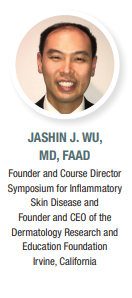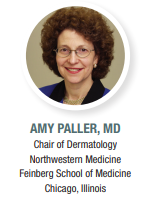With Jashin J. Wu, MD, FAAD, Wilson Liao, MD, and Amy Paller, MD
______________________________________________________________________________________________________________________________
NEW GUIDELINE TAKEAWAYS

Jashin J. Wu, MD, FAAD, a member of the American Academy of Dermatology/National Psoriasis Foundation’s Psoriasis Guidelines Committee, presented highlights from the 6 published updated psoriasis guidelines in 2019 to 2021.
“The previous psoriasis guidelines were from 2008 to 2011 and 10 years is a long time for medical advances. There are many changes in the latest six updates,” noted Dr. Wu.
Dr. Wu’s takeaway points from each of the guideline updates are as follows:
Guideline: Care for management and treatment of psoriasis with topical therapy and alternative medicine modalities for psoriasis severity measures.1
“In this update, we recommend use of off-label tacrolimus for facial psoriasis or inverse psoriasis for up to eight weeks,” he said.
Guideline: Care for the management of psoriasis with systemic nonbiologic therapies.2
“It is not necessary to do a liver biopsy in patients who have had more than 3.5 or 4 cumulative grams of methotrexate in their lifetime. To prevent liver biopsies, we can now do liver imaging tests,” Dr. Wu said.
Guideline: Management and treatment of psoriasis in pediatric patients.3
“Uveitis is not a big risk in children with psoriasis. But uveitis may occur in children with psoriatic arthritis, plus or minus psoriasis,” he noted.

Guideline: Care for the management and treatment of psoriasis with phototherapy.4
“We found that the pulse dye laser is effective for nail psoriasis, and monthly pulse dye laser is more effective than twice weekly excimer laser for nail psoriasis,” Dr. Wu said.
Guideline: Care for the management and treatment of psoriasis with biologics.5
“I would say the most important point is if patients are not at high risk for tuberculosis (TB) and are not on a tumor necrosis factor (TNF) inhibitor, they do not need to get annual TB testing anymore,” he said.
Guideline: Management and treatment of psoriasis with awareness and attention to comorbidities.6
“There is some data from my group and others that seems to indicate that patients on biologics may improve their risk of major adverse cardiovascular events (MACE),” Dr. Wu said. “Most of that data is for TNF inhibitors.”
______________________________________________________________________________________________________________________________
SCALP AND NAIL PSORIASIS

Wilson Liao, MD, presented an update on scalp, nail, and inverse psoriasis.
“There is increasing recognition that scalp and nail psoriasis are very important to the patient experience and therefore should be treated adequately. A recent publication from the International Psoriasis Council advocates that psoriasis patients with special site involvement, including scalp and nail, should be eligible for systemic therapies as first-line agents,” said Dr. Liao7
Scalp and nail involvement is common among patients with psoriasis in typical locations, including the trunk and extremities.
“Patients with nail psoriasis have a higher frequency of psoriatic arthritis,” Dr. Liao said.
Options for treating nail psoriasis depend on how many nails are involved and whether involvement primarily affects the nail bed (e.g., oil drop discoloration, onycholysis, subungual hyperkeratosis) or the nail matrix (e.g., pitting, crumbling of the nail plate, leukonychia).
“Therapeutic options include topical therapies, localized injections, and systemic/biologic therapies. Interleukin 17 (IL-17) inhibitors may have the fastest onset of action in nail psoriasis, though over time the IL-17, IL-23, and TNF-alpha inhibitors all appear to have similar efficacy,” Dr. Liao said. “For nail bed disease affecting three or fewer nails, topical corticosteroids or vitamin D/corticosteroid combinations can be used. For the treatment of nail matrix involving three or fewer nails, first-line therapy should be intralesional corticosteroids or methotrexate. For multiple nail disease, the IL-17 inhibitors may have the fastest onset of action for nail psoriasis, though over time the IL-17, IL-23, and TNF-alpha inhibitors all appear to have similar efficacy.”8
Topical treatments for scalp psoriasis can be divided into two categories: clearing agents (topical steroids +/- calcipotriene) and maintenance/adjunct agents (calcipotriene, tar and salicylic acid shampoos), according to Dr. Liao.
“Refractory patients may be considered for phototherapy, including at-home handheld devices or in-office excimer laser, or biologic agents, such as secukinumab, guselkumab, and apremilast, which have scalp data on their FDA labeling,” he said.9

_____________________________________________________________________________________________________________________________
PEDIATRIC PSORIASIS PEARL
Amy Paller, MD, presented on treating kids with psoriasis and offers The Dermatology Digest readers these 3 practice pearls.

“If starting with topical therapy, hit hard with a combination of a super potent steroid and vitamin D3 analogue for the first few weeks. The combination used can be commercially available or a 1:1 mix (in the hand) of compatible ingredients before application,” Dr. Paller said. “Although never tested in children, I typically then continue on weekends with the steroid and twice-daily vitamin D3 analogue on weekdays.”
For sensitive areas, like the face and groin, topical calcineurin inhibitors are Dr. Paller’s treatment of choice.

“I tend to go for tacrolimus 0.1% ointment (and often use Goodrx.com to find the cheapest price of the generic formulation for my patients),” she said.
For those who need to advance to systemics, who have at least 10% body surface area, in difficult areas (e.g., areas involving nails), and/or are recalcitrant to topicals, it’s about shared decision-making based on access and parental and child concerns about safety, according to Dr. Paller.
By Lisette Hilton
References
- Elmets CA, Korman NJ, Prater EF, et al. Joint AAD-NPF guidelines of care for the management and treatment of psoriasis with topical therapy and alternative medicine modalities for psoriasis severity measures. J Am Acad Dermatol. 2021 Feb;84(2):432-470. doi: 10.1016/j.jaad.2020.07.087. Epub 2020 Jul 30. PMID: 32738429.
- Menter A, Gelfand JM, Connor C, et al. Joint American Academy of Dermatology-National Psoriasis Foundation guidelines of care for the management of psoriasis with systemic nonbiologic therapies. J Am Acad Dermatol. 2020 Jun;82(6):1445-1486. doi: 10.1016/j.jaad.2020.02.044. Epub 2020 Feb 28. PMID: 32119894.
- Menter A, Cordoro KM, Davis DMR, et al. Joint American Academy of Dermatology-National Psoriasis Foundation guidelines of care for the management and treatment of psoriasis in pediatric patients. J Am Acad Dermatol. 2020 Jan;82(1):161-201. doi: 10.1016/j.jaad.2019.08.049. Epub 2019 Nov 5. Erratum in: J Am Acad Dermatol. 2020 Mar;82(3):574. PMID: 31703821.
- Elmets CA, Lim HW, Stoff B, et al. Joint American Academy of Dermatology-National Psoriasis Foundation guidelines of care for the management and treatment of psoriasis with phototherapy. J Am Acad Dermatol. 2019 Sep;81(3):775-804. doi: 10.1016/j.jaad.2019.04.042. Epub 2019 Jul 25. Erratum in: J Am Acad Dermatol. 2020 Mar;82(3):780. PMID: 31351884.
- Greenspan A, Popik S. Comment on “Joint AAD-NPF guidelines of care for the management and treatment of psoriasis with biologics”. J Am Acad Dermatol. 2019 Aug;81(2):e45. doi: 10.1016/j.jaad.2019.03.068. Epub 2019 Mar 29. PMID: 30930086; PMCID: PMC6699145.
- Elmets CA, Leonardi CL, Davis DMR, et al. Joint AAD-NPF guidelines of care for the management and treatment of psoriasis with awareness and attention to comorbidities. J Am Acad Dermatol. 2019 Apr;80(4):1073-1113. doi: 10.1016/j.jaad.2018.11.058. Epub 2019 Feb 13. PMID: 30772097.
- Strober B, Ryan C, van de Kerkhof P, et al. International Psoriasis Council Board Members and Councilors. Recategorization of psoriasis severity: Delphi consensus from the International Psoriasis Council. J Am Acad Dermatol. 2020 Jan;82(1):117-122. doi: 10.1016/j.jaad.2019.08.026. Epub 2019 Aug 16. PMID: 31425723.
- Hadeler E, Mosca M, Hong J, Brownstone N, Bhutani T, Liao W. Nail psoriasis: a review of effective therapies and recommendations for management. Dermatol Ther (Heidelb). 2021 Jun;11(3):799-831. doi: 10.1007/s13555-021-00523-x. Epub 2021 May 12. PMID: 33978917; PMCID: PMC8163925.
- Mosca M, Hong J, Hadeler E, Brownstone N, Bhutani T, Liao W. Scalp psoriasis: a literature review of effective therapies and updated recommendations for practical management. Dermatol Ther (Heidelb). 2021 Jun;11(3):769-797. doi: 10.1007/s13555-021-00521-z. Epub 2021 Apr 24. PMID: 33893995; PMCID: PMC8163911.
Disclosures
Jashin J. Wu, MD, served as a consultant for AbbVie, Allergan, Almirall, Amgen, Arcutis, Bristol Myers Squibb, Celgene, Dermira, Dr. Reddy’s Laboratories, Eli Lilly and Company, Janssen Biotech, LEO Pharma, Novartis, Ortho Dermatologics, Pfizer, Inc, Promius Pharma, Regeneron, Sun Pharmaceutical Industries, Ltd.. UCB, and Valeant Pharmaceuticals North America, LLC receiving fees and/or honoraria; as a speaker for AbbVie, Celgene, Novartis, Regeneron, Sanofi Genzyme, Sun Pharmaceutical Industries Ltd, UCB, and Valeant Pharmaceuticals North America, LLC receiving honoraria; and as a principal/investigator for AbbVie, Amgen, AstraZeneca, Boehringer Ingelheim, Coherus Biosciences, Dermira, Eli Lilly and Company, Janssen Pharmaceuticals, Inc, Merck & Co, Inc, Novartis, Pfizer, Inc, Regeneron, Sandoz (a Novartis Company), and Sun Pharmaceutical Industries, Ltd receiving research and/or grant funding.
Wilson Liao, MD, has received research grant funding from AbbVie, Amgen, Janssen Pharmaceuticals, Inc, LEO Pharma, Novartis, Pfizer, Inc, Regeneron, and TRex Bio.
Amy S. Paller, MD, is a consultant with honorarium for AbbVie, Almirall, Llc, AnaptysBio, Inc, Boehringer Ingelheim, Eli Lilly and Company, Exicure, Novartis, Pfizer, Inc, and UCB, as well as an investigator for AbbVie, Eli Lilly and Company, Janssen Biotech, and UCB. She is also on the Data Safety Monitoring Board for AbbVie and Galderma.

